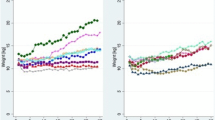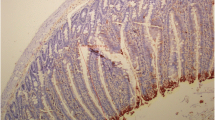Abstract
When benzalkonium chloride solution (BACs) is locally applied, to the serosal surface of the intestine, it causes intrinsic denervation (ID) of the myenteric plexus (MP), changes intestinal morphology, and slows intestinal passage by prolonging small-bowel transit time. These effects of ID suggest that chemically-induced bowel denervation may be useful in the treatment of short-bowel syndrome (SBS). How ID affects intestinal morphology in rats with SBS has not previously been investigated. A 75%–80% mid-small-bowel resection was performed in 20 rats with mean body weight 247 ± 30 g. The proximal and distal 2 cm of the resected bowel were examined histologically. After intestinal continuity was maintained by end-to-end anastomosis, a 2-cm jejunal segment was marked with silk sutures to form the test segment. BACs 0.1% was applied to 10 of the 20 test segments according to the modified Fox method, resulting in MP destruction (G1). Saline solution was applied to the other 10 test segments to form the control group (G2). Three months later, the rats were killed and the jejunal, ileal, and test segments were evaluated morphologically. Results were expressed as mean ± standard deviation. The Wilcoxon parametric test was performed to compare the groups during the operation and after death, while the Mann–Whitney U-test was used to compare the data in G1 and G2. No intestinal obstruction was observed in either group. In G1, the body weight increased by 19.1% and the total small-intestinal lengthening was 62.2% (P < 0.05). In the test segment of G1, 75% of the ganglia in the MP were destroyed and villus height, crypt depth, intestinal muscle thickness, number of enterocytes, and villus density increased compared to G2. In the ileal segments of G1, there was an increase of 28.8% in intestinal diameter, 14% in muscle thickness, and 15% in villus density (P < 0.05). No change was observed in the untreated jejunal segments of G1 and G2. Thus, ID of the MP after segmental BACs application of the jejunal level: (1) does not cause intestinal obstruction after 3 months; (2) the increase in bowel diameter in the test and ileal segments increases the absorptive surface of the mucosa; (3) the morphologic changes in the test and ileal segments verify an increase in intestinal adaptation; and (4) BACs application in rats with SBS is an easy procedure with no morbidity or mortality, and can be used to increase intestinal adaptation in rats with SBS.
Similar content being viewed by others
Author information
Authors and Affiliations
Additional information
Accepted: 1 February 2000
Rights and permissions
About this article
Cite this article
Şencan, A., Mir, E., Karaca, I. et al. Effects of intrinsic denervation on intestinal morphology in rats with short-bowel syndrome. Pediatr Surg Int 16, 554–558 (2000). https://doi.org/10.1007/s003830000443
Issue Date:
DOI: https://doi.org/10.1007/s003830000443




